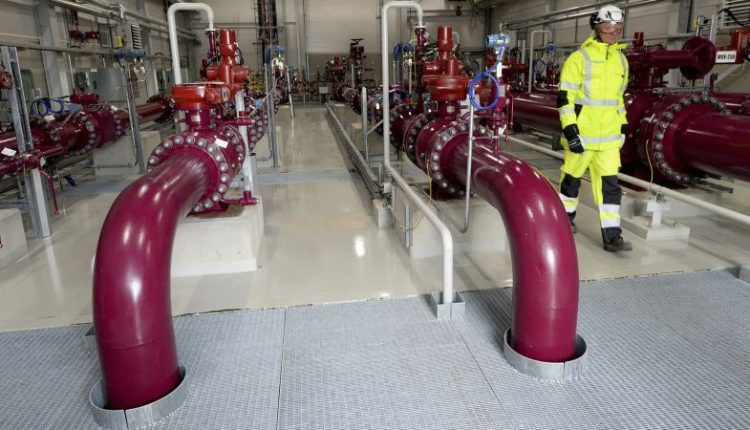A pipeline ferrying natural gas between Finland and Estonia has become the focus of an international investigation into a potential act of sabotage, raising fresh concerns about the security of Europe’s energy infrastructure a year after explosions shut down the vital Nord Stream 1 pipeline.
Gasgrid, Finland’s gas transmission operator, said Sunday that it had temporarily shut the 95-mile-long Balticconnector pipeline, running under the Baltic Sea, over a suspected leak. It will take at least five months before the pipeline can be reopened, Gasgrid said Wednesday.
Finnish President Sauli Niinistö has said the gas leak, as well as damage to an underwater communications cable, was likely “caused by external activity.” Fears that it may have resulted from an attack have contributed to a rise of more than 20% in European wholesale gas prices this week.
NATO Secretary General Jens Stoltenberg said Wednesday that it was important to establish the nature of the damage and how it had happened.
“If it is proven to be a deliberate attack on NATO critical infrastructure, then this will be of course serious, but it will also be met by a united and determined response from NATO,” Stoltenberg told reporters at a summit in Brussels.
The Balticconnector is part of a wider network that carries gas from Lithuania, through Latvia, Estonia and onto Finland. Since April, Finland has also been using the pipeline to send gas back to Estonia depending on demand, sourcing the fuel from a new liquefied natural gas (LNG) terminal on the Finnish side of the pipeline.
As a connecting pipeline, Balticconnector doesn’t import gas into Europe, nor does it carry very much. With a capacity of 2.6 billion cubic meters a year, it represents just a fraction of the total 415 billion cubic meters of gas supplied to the European Union and the United Kingdom last year — 0.63%, to be exact.
Finland and Estonia are not especially reliant on natural gas for their energy needs either, analysts tell CNN. Moreover, Finland can still source gas via its LNG terminal, and Estonia is still connected to the European gas grid via Lithuania.
So why does the pipeline’s shuttering matter?
Jack Sharples, senior research fellow at the Oxford Institute for Energy Studies, has an idea.
The incident is “less about disrupting European gas supply and more about raising bigger questions about the safety and security of offshore infrastructure, not just gas pipelines,” he told CNN, adding that electricity and communications cables also run along the bed of the Baltic Sea.
Gasgrid and its Estonian counterpart Elering “noticed an unusual drop in pressure in the Balticconnector offshore gas pipeline” on Sunday morning, Gasgrid said Tuesday.
“It is reasonable to suspect that the cause of the incident was damage to the offshore gas pipeline,” the company said in a statement.
NORSAR, Norway’s seismology research center, said Tuesday that it had “detected a probable explosion along the Finnish coast of the Baltic Sea” in the vicinity of the damaged gas pipeline and data cable in the early hours of Sunday morning.
Finnish authorities have launched a criminal investigation into possible sabotage at the Balticconnector, while Estonia has opened a criminal probe into the malfunction of the communications cable, Estonia’s Prime Minister Kaja Kallas told reporters Tuesday.
Authorities, and energy traders, are understandably nervous. A little over a year ago, a series of explosions rocked the Nord Stream 1 pipeline — once the main artery delivering Russian gas to Europe via Germany — and Nord Stream 2. The blasts were widely considered to be the result of sabotage. It is still not clear who was behind the attacks.
Simone Tagliapietra, a senior fellow at the Bruegel think tank, called Sunday’s incident “a very important alarm bell” for the EU.
“Europe cannot afford the sabotage of its pipelines and LNG infrastructure,” he told CNN. “If these kinds of acts happen on international pipelines bringing gas to Europe from Norway or Algeria, that would have significant consequences on the European gas market, the European gas prices, and therefore the economy.”
In a squeezed global gas market, even relatively small upsets can send investors into a tizzy, sending prices higher.
Futures prices for Europe’s benchmark gas contract jumped 15% Monday following Gasgrid’s announcement that it had shut the Balticconnector.
Over the course of this week, prices have risen more than 20% as news of the pipeline’s closure has coincided with an announcement by US gas producer Chevron (CVX) that some of its Australian workers planned to strike this month.
The escalating conflict in Israel, triggered by a deadly assault by Hamas militants on Israeli civilians Saturday, has also raised fears over global gas supply. On Monday, citing security concerns, Chevron said it had shut down a natural gas field off the coast of Israel — a site supplying 70% of the country’s energy needs for power generation.
“The European [gas] market remains very tight, and any news is having an impact,” said Sharples at the Oxford Institute for Energy Studies.
— James Frater and Sharon Braithwaite contributed reporting.
Read the full article here

